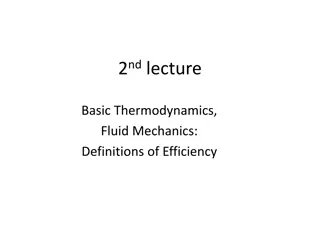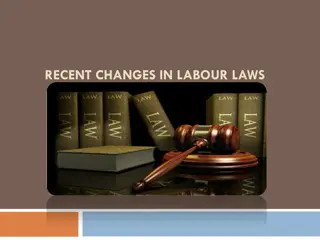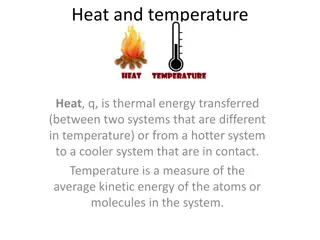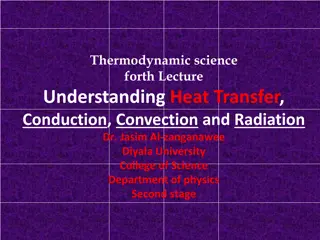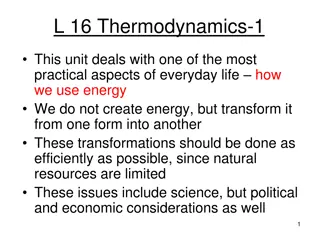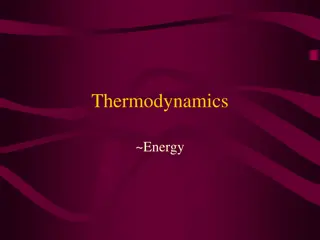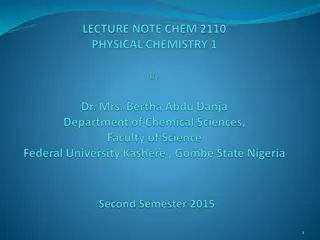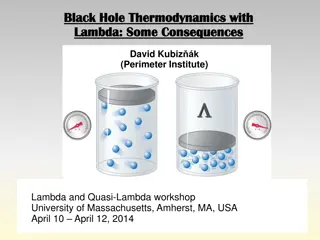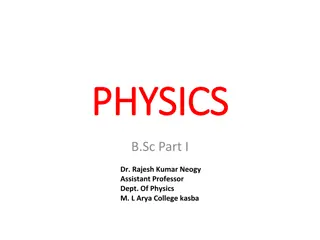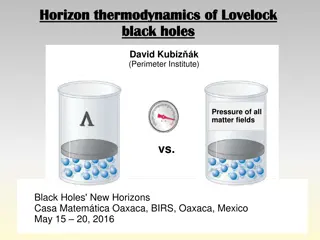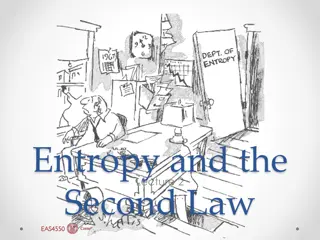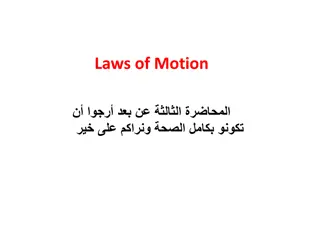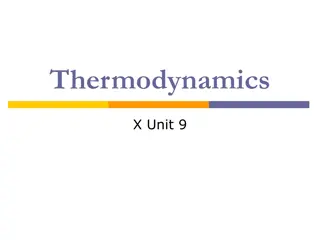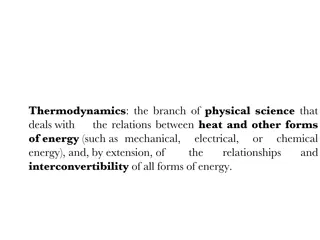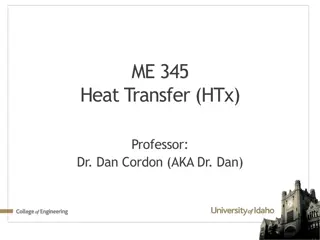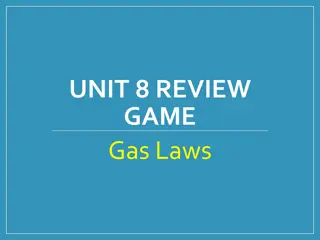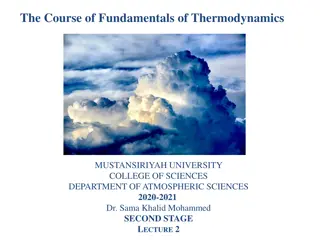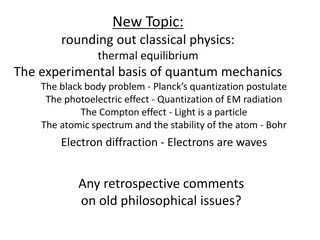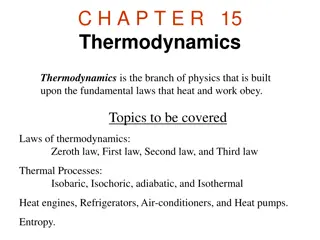Introduction to Thermodynamics: Laws, Concepts, and Processes
Delve into the fascinating realm of thermodynamics through an exploration of its laws, core concepts like temperature and entropy, classical versus statistical perspectives, and key processes such as adiabatic and isothermal transformations. Uncover the essence of energy, work, heat, and their intricate interplay within systems as you journey through this fundamental branch of physics.
Download Presentation

Please find below an Image/Link to download the presentation.
The content on the website is provided AS IS for your information and personal use only. It may not be sold, licensed, or shared on other websites without obtaining consent from the author.If you encounter any issues during the download, it is possible that the publisher has removed the file from their server.
You are allowed to download the files provided on this website for personal or commercial use, subject to the condition that they are used lawfully. All files are the property of their respective owners.
The content on the website is provided AS IS for your information and personal use only. It may not be sold, licensed, or shared on other websites without obtaining consent from the author.
E N D
Presentation Transcript
Dept. Of Physics GDC Rajouri Laws of Thermodynamics Presented by: Asif Ajaz Lone Asst. Professor of Physics
Thermodynamics Thermodynamics is the study of the effects of work, heat, and energy on a system Thermodynamics is only concerned with macroscopic (large-scale) changes and observations
Getting Started All of thermodynamics can be expressed in terms of four quantities Temperature (T) Internal Energy (U) Entropy (S) Heat (Q) These quantities will be defined as we progress through the lesson
Classical vs Statistical Classical thermodynamics concerns the relationships between bulk properties of matter. Nothing is examined at the atomic or molecular level. Statistical thermodynamics seeks to explain those bulk properties in terms of constituent atoms. The statistical part treats the aggregation of atoms, not the behavior of any individual atom
Introduction According to British scientist C. P. Snow, the three laws of thermodynamics can be (humorously) summarized as 1. You can t win 2. You can t even break even 3. You can t get out of the game
1.0 You cant win (1stlaw) The first law of thermodynamics is an extension of the law of conservation of energy The change in internal energy of a system is equal to the heat added to the system minus the work done by the system U = Q - W
1.1 Process Terminology Adiabatic no heat transferred Isothermal constant temperature Isobaric constant pressure Isochoric constant volume
1.1.1 Adiabatic Process An adiabatic process transfers no heat therefore Q = 0 U = Q W When a system expands adiabatically, W is positive (the system does work) so U is negative. When a system compresses adiabatically, W is negative (work is done on the system) so U is positive.
1.1.2 Isothermal Process An isothermal process is a constant temperature process. Any heat flow into or out of the system must be slow enough to maintain thermal equilibrium For ideal gases, if T is zero, U = 0 Therefore, Q = W Any energy entering the system (Q) must leave as work (W)
1.1.3 Isobaric Process An isobaric process is a constant pressure process. U, W, and Q are generally non- zero, but calculating the work done by an ideal gas is straightforward W = P V Water boiling in a saucepan is an example of an isobar process
1.1.4 Isochoric Process An isochoric process is a constant volume process. When the volume of a system doesn t change, it will do no work on its surroundings. W = 0 U = Q Heating gas in a closed container is an isochoric process
1.2 Heat Capacity The amount of heat required to raise a certain mass of a material by a certain temperature is called heat capacity Q = mcx T The constant cx is called the specific heat of substance x, (SI units of J/kg K)
1.2.1 Heat Capacity of Ideal Gas CV = heat capacity at constant volume CV = 3/2 R CP = heat capacity at constant pressure CP = 5/2 R For constant volume Q = nCV T = U The universal gas constant R = 8.314 J/mol K
2.0 You cant break even (2nd Law) Think about what it means to not break even . Every effort you put forth, no matter how efficient you are, will have a tiny bit of waste. The 2nd Law can also be stated that heat flows spontaneously from a hot object to a cold object (spontaneously means without the assistance of external work)
2.1 Concerning the 2nd Law The second law of thermodynamics introduces the notion of entropy (S), a measure of system disorder (messiness) U is the quantity of a system s energy, S is the quality of a system s energy. Another C.P. Snow expression: not knowing the 2nd law of thermodynamics is the cultural equivalent to never having read Shakespeare
2.2 Implications of the 2nd Law Time marches on If you watch a movie, how do you know that you are seeing events in the order they occurred? If I drop a raw egg on the floor, it becomes extremely disordered (greater Entropy) playing the movie in reverse would show pieces coming together to form a whole egg (decreasing Entropy) highly unlikely!
2.3 Direction of a Process The 2nd Law helps determine the preferred direction of a process A reversible process is one which can change state and then return to the original state This is an idealized condition all real processes are irreversible
2.4 Heat Engine A device which transforms heat into work is called a heat engine This happens in a cyclic process Heat engines require a hot reservoir to supply energy (QH) and a cold reservoir to take in the excess energy (QC) QH is defined as positive, QC is negative
2.4.1 Cycles It is beyond the scope of this presentation, but here would be a good place to elaborate on: Otto Cycle Diesel Cycle Carnot Cycle Avoid all irreversible processes while adhering to the 2nd Law (isothermal and adiabatic only)
2.4.2 The Carnot Cycle Image from Keta - Wikipedia
2.4.2.1 Carnot explained Curve A (1 2): Isothermal expansion at TH Work done by the gas Curve B (2 3): Adiabatic expansion Work done by the gas Curve C (3 4): Isothermal compression at TC Work done on the gas Curve D (4 1): Adiabatic compression Work done on the gas
2.4.2.2 Area under PV curve The area under the PV curve represents the quantity of work done in a cycle When the curve goes right to left, the work is negative The area enclosed by the four curves represents the net work done by the engine in one cycle
2.5 Engine Efficiency The thermal efficiency of a heat engine is e = 1 + QC/QH The engine statement of the 2nd Law: it is impossible for any system to have an efficiency of 100% (e = 1) [Kelvin s statement] Another statement of the 2nd Law: It is impossible for any process to have as its sole result the transfer of heat from a cooler object to a warmer object [Clausius s statement]
2.6 Practical Uses Automobile engines, refrigerators, and air conditioners all work on the principles laid out by the 2nd Law of Thermodynamics Ever wonder why you can t cool your kitchen in the hot summer by leaving the refrigerator door open? Feel the air coming off the back - you heat the air outside to cool the air inside See, you can t break even!
3.0 You cant get out (3rd Law) No system can reach absolute zero This is one reason we use the Kelvin temperature scale. Not only is the internal energy proportional to temperature, but you never have to worry about dividing by zero in an equation! There is no formula associated with the 3rd Law of Thermodynamics
3.1 Implications of 3rd Law MIT researchers achieved 450 picokelvin in 2003 (less than of one billionth!) Molecules near these temperatures have been called the fifth state of matter: Bose-Einstein Condensates Awesome things like super-fluidity and super- conductivity happen at these temperatures Exciting frontier of research
4.0 The Zeroth Law The First and Second Laws were well entrenched when an additional Law was recognized (couldn t renumber the 1st and 2nd Laws) If objects A and B are each in thermal equilibrium with object C, then A and B are in thermal equilibrium with each other Allows us to define temperature relative to an established standard
4.1 Temperature Standards See Heat versus Temperature slides for a discussion of these two concepts, and the misconceptions surrounding them Heat is energy transfer Temperature is proportional to internal energy Fahrenheit, Celsius, and Kelvin temp scales Thanks Asif Ajaz Lone
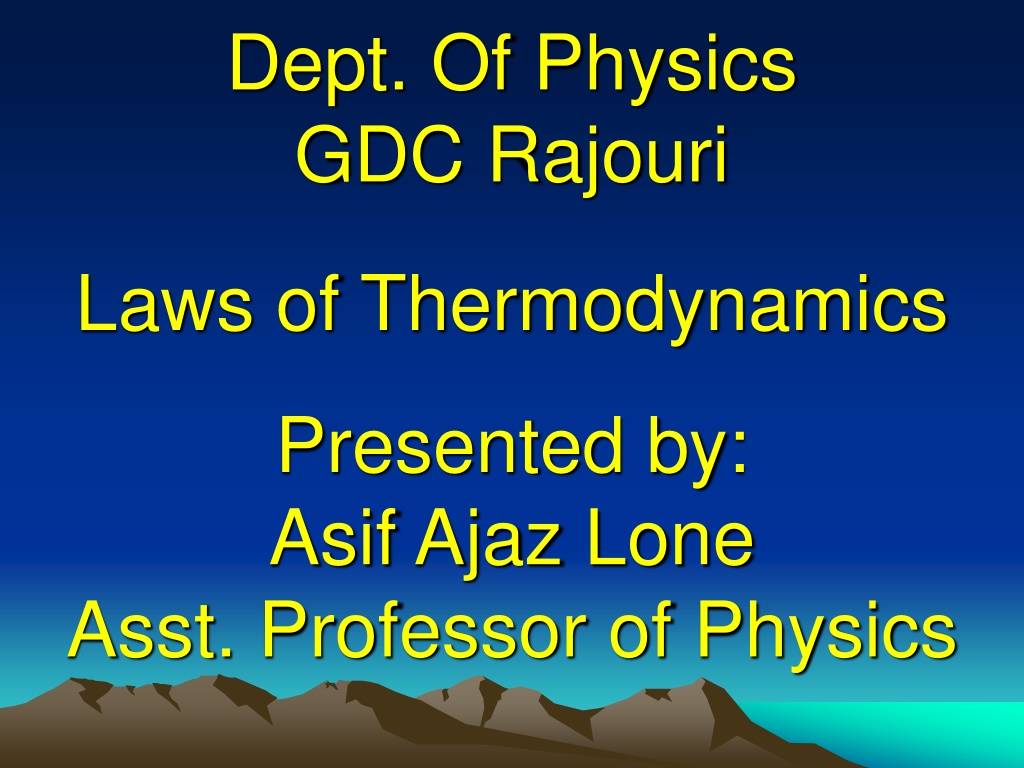
 undefined
undefined




